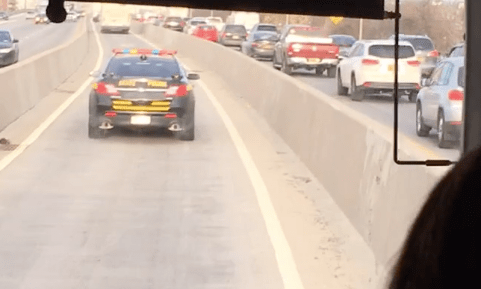Eyes on the Street: Staten Island Express Bus is Great, But Expensive

There is a quick and pleasant way to get from Staten Island to Manhattan during the morning rush, but it comes with a high price tag.
Staten Island’s recently redesigned express bus routes to the city cost much more than other forms of public transportation — and could even be more expensive than driving.
It costs $13 a day to get to and from the Rock in style, on a tour bus with comfortable seats, big windows, individual USB ports and air conditioning, and, for those still buying print newspapers, a reading lamp.
That’s a steep increase over the $5.50 pricetag for a round trip on the Island’s other means of transportation — buses or the Staten Island Railway to the ferry with a free transfer to a bus or train in Manhattan or what Staten Islanders pay to get over the Verrazzano-Narrows Bridge with their E-ZPass.
Still, you get what you pay for.
That’s because there is no faster route to the Manhattan that I, a life-long resident of the forgotten borough, have experienced in the more than 25 years of making the journey.
I recently hopped on the new SIM15 bus on Richmond Road and Seaview Avenue in Dongan Hills — about a third of the way down the Railway’s line and home to the incomparable Lee’s Tavern — at 8:10 a.m., and got off at Rector Street and Trinity Place in Manhattan just 37 minutes later.
To be clear, this is a world record. My trips to Manhattan and Brooklyn were nearly alway an hour-and-a-half of drudgery whether I used public transportation or drove. (Full disclosure: My guaranteed fastest route to work in MetroTech in Brooklyn was by bicycle, which took 50 to 55 minutes including a trip on the ferry and a pleasant ride over the Brooklyn Bridge. Best of all? That commute was free!)
What makes this miraculous time possible is the nearly two-year-old high-occupancy vehicle lane that connects the bridge to the Hugh L. Carey Battery Tunnel.
On my commute, we moseyed down Richmond Road and turned onto the expressway’s service road, picking up 23 additional passengers at six stops. The bus was about full when we got on the highway at the foot of the fabled span, crossed three lanes of traffic, and got into the H.O.V. lane on the upper level.
Once there, we zoomed past cars on the bridge that were practically at a standstill, and continued zooming until we got north of Sunset Park, where the H.O.V. lane allows some Brooklyn buses, motorcycles, and other vehicles with at least three passengers in on the fun. Once back in a protected lane, we zipped over the Gowanus Canal and only slowed down at a checkpoint where cops were making sure scofflaws weren’t using the lane. (Note: No one was pulled over.)
All told, it took us about 20 minutes to get from the bridge to my stop. Amazing.
To get to the same place using the nearby train required catching an 8:17 train to the 8:45 boat into Manhattan, which would get me to Whitehall Street by about 9:15 (the ferry ride only takes 25 minutes, but you have to factor in unloading time). And it’s still a 10-minute walk to Trinity Church.
The local bus would be a crapshoot, getting me to the ferry by for either the 8:45 or 9 am boat, depending on traffic. Either way can’t compare to 37 minutes to Lower Manhattan.
And by car? Well, I would have been sitting in that traffic that my bus flew by.
Is there trouble in paradise? Last week, two borough presidents and three councilmen from Brooklyn and Staten Island asked Mayor Bill de Blasio to improve the weekday morning H.O.V. lane in Brooklyn by extending it for two additional hours (from 5 a.m. until 11 a.m. instead of 6 a.m. until 10 a.m.), increasing enforcement to keep scofflaws out, and prohibiting tour buses from entering the lane.
These are all reasonable measures to take to ensure buses can keep getting transit riders from Staten Island to and from the city in such a short amount of time that they’re willing to pay $13 a day. And the pols are right: a good way to get commuters onto these buses and out of their cars is to keep service running smoothly.
But the best way? Lower the price. The $260-a-month cost is still a discount to what New Jersey commuters other than Whoopi Goldberg pay to get to work, but it is much more expensive than $110 your average subway rider pays for his monthly commute.
The price may be part of the reason Staten Island express bus ridership dropped from a high of 34,791 in 2013 to 32,896 in 2017 (2018 numbers aren’t available yet). The fare has gone up $1 each way since 2012. Still, Staten Islanders comprise the vast majority of users of the MTA’s roughly 40,000 daily users of the express bus system, which includes buses from Brooklyn, the Bronx, and Queens.
In their letter to the mayor, the politicians — including Brooklyn Beep Eric Adams, his Rock counterpart Jimmy Oddo, plus Council Members Steven Matteo, Justin Brannan, and Carlos Manchaca — claimed “there is no panacea that will make rush-hour commuting a quick and pleasant experience.”
But that misses a larger point: Sure, there will never again be such a commute for the single driver. But there already is for those who take the bus.
Brooklyn and Staten Island politicians call on Mayor de Blasio to improve bus service in HOV lanes by Gersh Kuntzman on Scribd
